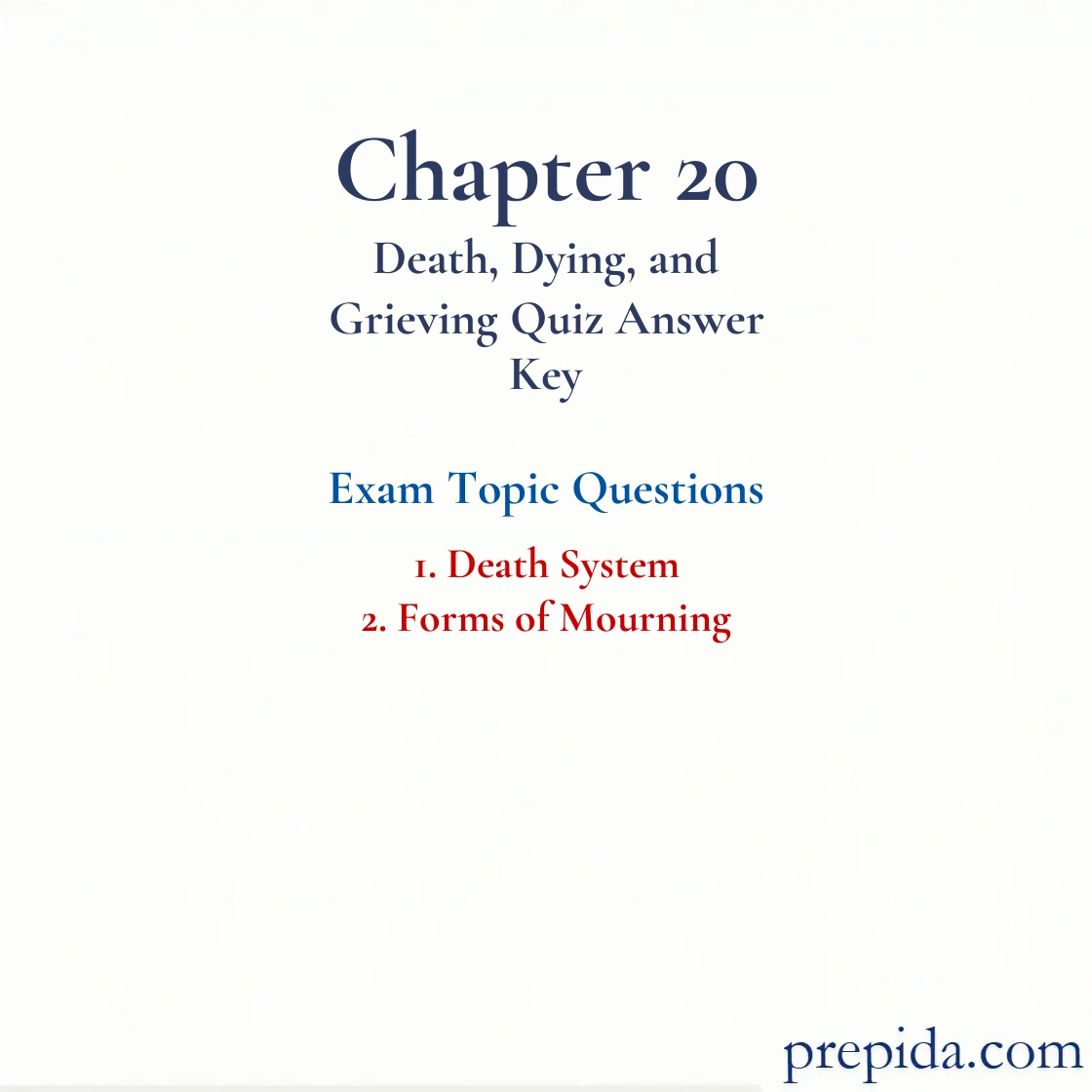
Which of the following religions believes in reincarnation?
- Orthodox Judaism
- Methodism
- Buddhism
- Roman Catholicism
Religion: An organized set of beliefs, practices, rituals, and symbols that increases an individual’s connection to a sacred or transcendent other (God, higher power, or higher truth).
Which of the following is true of the American attitude toward death?
- Americans are conditioned from early in life to live as mere mortals.
- It is not uncommon for Americans to reach adulthood without having experienced the death of someone close.
- To live a full life and die with glory is the prevailing goal of the Americans.
- Americans do not use any symbols associated with death.
Grief: The emotional numbness, disbelief, separation anxiety, despair, sadness, and loneliness that accompany the loss of someone we love.
Which of the following emotional reactions is most common in the Gond culture of India in response to death?
- peace
- acceptance
- denial
- anger
Anger: Kübler-Ross’ second stage of dying, in which the dying person’s denial gives way to anger, resentment, rage, and envy.
In the Gond culture of India, death is believed to be caused by
- natural forces.
- an angry supreme being.
- the ill will of others in the community.
- magic and demons.
In the Tanala culture of Madagascar, death is believed to be caused by
- natural forces.
- magic and demons.
- ill will of others in the community.
- an evil spirit.
Nature-Nurture Issue: Debate about whether development is primarily influenced by nature or nurture. Nature refers to an organism’s biological inheritance, nurture to its environmental experiences.
"Aninut," "avelut," and "shivah" are all parts of the grieving process for people in the ________ community.
- Amish
- Jewish
- Muslim
- Protestant
Religion: An organized set of beliefs, practices, rituals, and symbols that increases an individual’s connection to a sacred or transcendent other (God, higher power, or higher truth).
In Judaism, ________ refers to the period between death and burial.
- sheolism
- avelut
- aninut
- shivah
Amnion: The part of the prenatal life-support system that consists of a sac containing a clear fluid in which the developing embryo floats.
Traditional Amish and Jewish cultures are similar in how they cope with death in that they both
- provide a lot of community support for the family over several months.
- have elaborate funeral ceremonies in church to symbolize the last passage from Earth.
- believe that grief is stronger for the whole community than for the individual family.
- expect families to unite and cope together with only minimal support or interference from the rest of the community.
Identify a criticism about the funeral industry in the United States.
- Critics claim that funerals tend to push surviving family members into depression and prolonged grief.
- Critics claim that funerals are not a part of the American culture and hence people should avoid them.
- Critics claim that funeral directors are just trying to make money and that embalming is grotesque.
- Critics claim that funerals seldom provide a form of closure to the relationship with the deceased.
In which of the following countries is cremation most popular?
- the United States
- Mexico
- Canada
- Japan
Which of the following statements is true of the popularity of cremation?
- Cremation is usually more popular in the United States than in Canada.
- Cremation is more popular in the Pacific region of the United States than in the South.
- Cremation is least popular in Japan and Asian countries.
- Cremation percentage in the United Sates has reduced since 1985.
In the Jewish tradition, the 30-day period following the burial including shivah is known as
- rendering.
- sheloshim.
- aninut.
- avelut.
Sensorimotor Stage: The first of Piaget’s stages, which lasts from birth to about 2 years of age; infants construct an understanding of the world by coordinating sensory experiences with motoric actions.
After her husband's death, Lorna had to start dealing with her finances. She has had to learn to balance a checkbook and pay the bills-things that her husband always did when he was alive. According to the dual-process model of coping with bereavement, Lorna is experiencing
- restoration-oriented stressors.
- loss-oriented stressors.
- complicated grief.
- disenfranchised grief.
Dual-Process Model: A model of coping with bereavement that emphasizes oscillation between two dimensions: (1) loss-oriented stressors, and (2) restoration-oriented stressors.
A changing identity, such as from "wife" to "widow," is an example of
- loss-oriented stressors.
- restoration-oriented stressors.
- denial of grief.
- complicated grief.
In the dual-process model of coping with bereavement, coping with loss and engaging in restoration can occur
- separately.
- consecutively.
- only several years after a death.
- concurrently.
Dual-Process Model: A model of coping with bereavement that emphasizes oscillation between two dimensions: (1) loss-oriented stressors, and (2) restoration-oriented stressors.
Which of the following is one of the main dimensions of the dual-process model of coping with bereavement?
- loss-oriented stressors
- relapse-oriented uplifts
- depression-oriented stressors
- denial-oriented traumas
Dual-Process Model: A model of coping with bereavement that emphasizes oscillation between two dimensions: (1) loss-oriented stressors, and (2) restoration-oriented stressors.
In the Jewish community, the members of a grieving family all walk together for a short distance to symbolize their
- common loss.
- unity in grief.
- return to society.
- community unity.
Which of the following statements is true of the dual-process model of coping with bereavement?
- Loss-oriented stressors exclude any positive or negative reappraisal of the loss.
- Restoration usually shatters assumptions about the world and one's own place in it.
- Restoration-oriented stressors is one of the key dimensions of the dual-process model.
- Coping with loss and engaging in restoration can occur only separately.